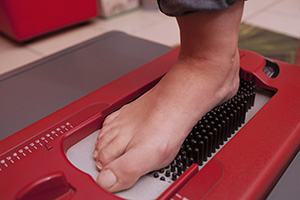 The feet are the only parts of the body that bear its entire weight and are involved in most physical activities. Wearing poor-fitting shoes can cause calluses, bunions, corns, hammer toe, cracks, infections, and even traumatic injuries. To maintain healthy feet, it is important that you wear good-quality, comfortable, and proper-fitting footwear. Choosing the right pair of shoes is essential in reducing the risk of foot problems, especially in people with certain medical conditions like diabetes.
The feet are the only parts of the body that bear its entire weight and are involved in most physical activities. Wearing poor-fitting shoes can cause calluses, bunions, corns, hammer toe, cracks, infections, and even traumatic injuries. To maintain healthy feet, it is important that you wear good-quality, comfortable, and proper-fitting footwear. Choosing the right pair of shoes is essential in reducing the risk of foot problems, especially in people with certain medical conditions like diabetes.
For people with foot conditions, special corrective shoes provide the following advantages:
- Limit mobility of the joint: These shoes help to relieve pain and reduce inflammation by limiting the mobility of the joint.
- Relieve pressure in certain areas: Relieving high pressure on certain areas of the foot helps prevent skin breakdown and foot ulcers.
- Accommodate, stabilize and support deformities: Specially designed shoes help to stabilize deformities to relieve pain and provide support to prevent further damage.
- Reduce shock and shearing: These special shoes help to reduce the amount of pressure applied on the foot vertically and horizontally to reduce shock and avoid skin breakdown.
Prescription shoes
Your doctor can recommend special prescription footwear, such as the following:
- Healing Shoes: These are prescribed for patients who have undergone treatment or surgery for sores and ulcers. This is a closed shoe that helps to protect your feet during the healing stage after surgery
- Shoe inserts: Also known as orthotics, these are removable insoles that help provide shock absorption and relieve high pressure.
- Custom-made shoes: These shoes are made using a cast or model of your foot to help treat severe deformities.
- In-depth shoes: These shoes possess extra depth compared to normal shoes and have large-volume, light-weight, shock-absorbing soles. This type of shoe easily accommodates orthotics, inserts and other diabetic foot deformities.
- External shoe modifications: The external part of the shoe is modified, which involves using shock-absorbing soles or foot-stabilizing materials.
Diabetic foot problems can be treated by proper usage of prescription shoes, stabilizing the bones and muscles, and by limiting movement of the feet.


